by Winding Pathways | Feb 22, 2024 | Birds, Mammals, Nature, Pests
We’ve blogged before about a white-footed mouse in the house. We read the story to our kids when they were little. Time after time we snuggled down with the book and they never got tired of hearing why the mouse might be cute but doesn’t belong in the house. A recent internet search for the specific book revealed lots of stories but not the one we wanted. Alas. So, here we are decades later writing again about a mouse in the house. Mice are cute but they do not belong in a house.
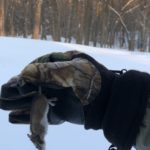
A person holding a mouse.
Whenever we’d find mouse evidence in our house, we’d set traps and usually catch a few, tossing their lifeless bodies outside for scavenger animals to eat. We do feel badly, but as the mother in the story said, “…a mouse does not belong in a house.”
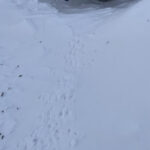
Path to the outdoor pantry
In January we changed our mind…..sort of. It was 20 below zero outside. Rich trudged through snow drifts to fill our bird feeders and noticed tracks, tiny mouse tracks, in the snow. A crafty white-footed mouse had scampered on top of the snow the night before to scrounge a few leftover seeds for dinner. Its tracks led to a snug nook out of the wind and under the deck.
An average White-footed mouse weighs a whopping .7 ounce. That’s seven-tenths of an ounce! That such a tiny creature can survive the howling wind and intense cold is a marvel of nature. Every nocturnal predator from coyotes to owls tries to capture and eat this diminutive mammal. But, it is wily, wary, and quick. Although not usually out during the day, it has to be mindful of cats and hawks looking for a meal.
-
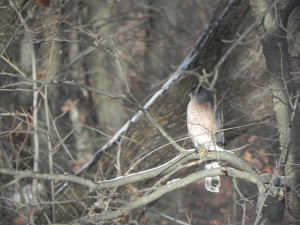
-
Patience
-
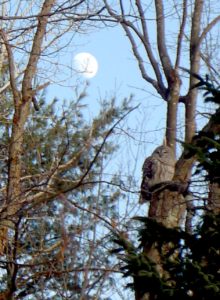
-
Nocturnal predator
After seeing those tracks, we felt a bit sorry for the animal that made them. We still won’t welcome a mouse into our house, but we’re happy it lives just outside in a safe place under the deck. He’s welcome to any seeds the birds overlooked.
To learn more about White Footed Mice and many other wild animals check out Animal Diversity Web out of the University of Michigan.
by Winding Pathways | Feb 8, 2024 | Birds, Nature
We live in a world of dizzying change in how we live, drive, and communicate. Like many people, we struggle to keep up with change and stay modern, so it’s comforting to know that some things simply don’t change. Fortunately, winter owls don’t change.
In March 1982 the Cedar Rapids GAZETTE printed Marion’s column on Iowa owls. It’s as relevant today as it was 42 years ago.
Audible In Winter
Now is the season of Winter Owls. The time of year when they are especially audible and often visible. Owls have a large vocabulary from courting to warning. YouTube is a great source to learn about and hear the sounds.
Barred and Great Horned Owls
We love hearing the clear and somewhat chilling calls of Barred and Great Horned Owls that reach our house over the snow and through the woods on clear, frosty winter nights. These two species live near our home year-round, with Barred Owls the most common. You can tell the Great Horned call that is low and throaty. The Barred calls out the familiar, “Who cooks for you?” refrain.
-

-
Waiting for supper.
-
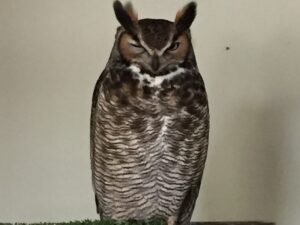
-
Injured owls find a safe home at the International Owl Center.
Screech Owls
A few times a year we drive to New Jersey to visit relatives and often are delighted to hear the two calls of a local Screech Owl serenade the evening. Its soft, haunting trill, called a tremolo, wafts over the lake. The “whinny”, think of a horse whinny, is territorial.
Northern Owls
Several of our friends trekked north this winter to see Great Grey and Northern Hawk-Owls. The Great Grey’s sound varies from a low-pitched “whoof” to an abrupt “meeh” to short screeches similar to a blue jay. The Northern Hawk Owl’s vocabulary ranges from high-pitched warbling sounds that carry across frozen landscapes to “chit-chit-chits” to a wimpy, scratchy screech. Think of a person with laryngitis trying to sing. All owls’ calls are amazing delights for those who wander outside and listen carefully on winter evenings.
-
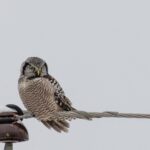
-
Northern Hawk Owl on wire. Photo Mark Ogden
-
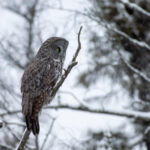
-
Great Gray Owl visits Northern Minnesota. Photo Mark Ogden
Snowy Owls
Many owl species don’t migrate much but these two sometimes dip southward from their usual winter range. So do magnificent Snowy Owls. In some especially frigid winters, they drift way south in what’s called an “irruption”. Birders flock to see them in open fields and even on the edge of airports! One of our favorite owls is the tiny Northern Saw-Whet Owl. They regularly come south in winter. Years ago, the Indian Creek Nature Center had a thick grove of young pines, a winter habitat the bird loves. Often, we could approach them closely on cold days. We even heard them once in the tiny ‘pine grove’ at our former residence.
How Do I Love Thee?
A fascinating aspect of owls is that they court and nest when it’s still winter! Although people rarely see courtship or mating, it is fascinating. Texas Backyard Wildlife captured video and the offering to the bigger female as a token of Love.
What prompts these impressive raptors to court, breed, and endure the hardships of incubating eggs in nature’s most desolate time of year? Necessity! Baby owls are a lot like human babies. They take a lot of care. For months owlets cry, eat, sleep, and poop. All the while growing. Just like humans. Young hatch late March into April when small rodents, the mainstay of owls, become more plentiful. Then, the adults really get busy foraging to feed the young tucked into nests of sticks.
Nests
Unlike some birds, Great Horned owl nests are not works of art. Adults return to the same wood tracts year after year and add only a few extra twigs. Young, like many teenagers, can make a shambles of the nest. The more practical Screech Owls prefer tree cavities and can be convinced to nest in wooden boxes adapted for them.
Parenting
During winter owls can be noisy and obvious as they wing across snowy fields at dusk. But after courtship and nesting, they quiet down. Like human adults, they are busy raising the young. By mid-summer people sometimes find “teenaged” owls flopping around on the ground or perched precariously on low branches. Like all fledglings, they are learning to fly. It’s best to leave them alone. The parent is nearby and the “kids” will make it without our help.
-
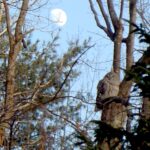
-
Waiting for supper.
-
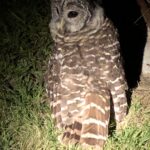
-
Grounded.
Tuck In and Read!
Winter is more than a time to hear and see owls. It’s a season to read about them. Our two favorite bird magazines featured owls in their winter 2024 editions. BIRD WATCHER’S DIGEST, features a species profile on Barn Owls. LIVING BIRD includes a fascinating article called HUNTING BY HEARING. The magazines are available online to subscribers. We enjoy both while curled up with the paper copy by the wood stove, and occasionally reading online articles. We also browse reliable internet sources and YouTube videos on owls.
Be Intrepid!
For intrepid winter visitors a trip to the International Owl Center in Houston, MN, is a delight. Their signature event, the International Festival of Owls is scheduled for March 1-3 this year.
-
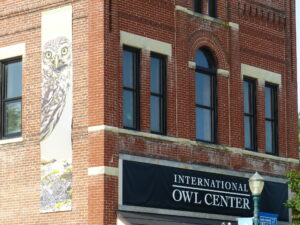
-
All things owl.
-
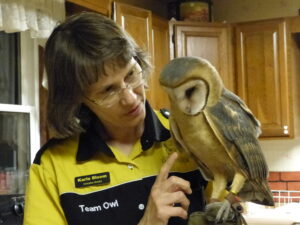
-
The International Owl Center promotes owl awareness.
Enjoy Winter
It’s winter. A season to enjoy the cold, snow, and OWLS.
by Winding Pathways | Jan 18, 2024 | (Sub)Urban Homesteading, Birds, Nature, Pests
Frustration Yields to Creativity
Reprising the blog on thwarting House Sparrows. Here is a recap of our initial frustration and subsequent ways to encourage native birds and discourage exotics.
As we wrote earlier, hordes of House Sparrows almost made us give up feeding birds. We’d fill our feeders each morning and hope to watch juncos, cardinals, chickadees, woodpeckers, and nuthatches visit on cold winter days. Unfortunately, hordes of House Sparrows began arriving. We don’t mind feeding a few, but dozens soon devoured all the expensive seed, leaving empty feeders for native species.
Coming Up Short on “Expert Advice”
We asked bird experts what we might do to discourage House Sparrows and tried several of their ideas. Nothing worked well, so we experimented and came up with a few tricks that seem to discourage House Sparrows to a degree yet let other species eat. Our tricks aren’t perfect and sparrows still come, but not in huge numbers.
Here’s what we did:
Altered filling time:
We noticed that cardinals, jays, chickadees, and nuthatches visited feeders in the early morning and late afternoon, but House Sparrows came more late morning and toward the middle of the day. So, we put out small amounts of seeds early in the morning and again in late afternoon. Often our feeders are empty mid-day when the house sparrows prefer to visit.
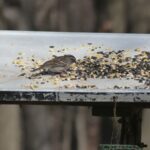
Eating from platform feeder
Sparrows enjoy feeding on the ground, on horizontal tables and other flat surfaces, and from silo-type feeders with long perches and large openings. We took down our standard silo feeders and replaced them with a silo shape feeder made of hardware cloth with a quarter-inch mesh.
In our quarter-inch mesh feeder, we put a mixture of black oil sunflower seeds and hulled peanuts. Native birds seemed better able to extract the sunflower from the mesh than House Sparrows. The peanuts don’t fit through the mesh, but many native bird species peck at them through the wire and extract pieces of peanuts. House Sparrows seem less able, or willing, to do this.
We also stopped feeding cracked corn and millet on the ground. Sparrows love them. Instead, we now toss full kernels of corn on the ground. Sparrows can’t swallow the big seeds and are unable to peck them apart. Woodpeckers, cardinals, blue jays, and nuthatches swallow or carry away the big seeds.
Put up with some House Sparrows
Our system helps deter these pesky exotic birds but is far from perfect. House Sparrows still visit and eat seeds but not as many as before we started using these tricks. Maybe they’ll work for you.
A few of you have shared. Now Others Can Share.
Winding Pathways is eager to learn other ways to deter House Sparrows. If you have discovered something that works, please let us know.
#
by Winding Pathways | Dec 7, 2023 | (Sub)Urban Homesteading, Birds, Nature
Why do Birds Fly Into Windows?
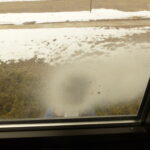
The spray makes the window opaque.
Windows, deadly for birds. According to the National Audubon Society, about one billion birds are killed every year when they crash into windows. About half collide with low commercial building windows with the rest crashing into home windows. Surprisingly few seem to crash into the high windows of skyscrapers.
Birds fly into windows because they just don’t see them and assume they’re about to zip through safe soft air. Sometimes they may see reflections of vegetation behind them and think they are zooming to a convenient perch.
How to Help a Bird
When Rich was director of the Indian Creek Nature Center, he’d often get calls from upset people who had just found a quivering bird beneath their window. In his experience one of two outcomes is likely. Either the bird will soon die or it will fully recover and fly off. He suggests leaving the bird alone for at least an hour unless it’s likely to fall prey to a hungry neighborhood cat. In that case, it is probably best to gently place it in a cardboard box to give it a chance to recover…or die.
Unfortunately, there’s no effective first-aid technique to reverse death. Hopefully, the bird will soon recover and speed away. If not, a respectful burial is in order.
Tips
Here are some tips from the Portland, Oregon, Audubon Chapter of the National Audubon Society for reducing window collisions:
- Place bird feeders away from large windows.
- Avoid putting house plants immediately inside windows. Birds may see them and attempt to fly to a perch.
- Put stickers/decals on the outside of windows. (Note: Many sources recommend these. Stickers can be bought online or at bird-feeding stores……but we, at Winding Pathways, have not found them very effective.
- Stretch netting across the outside of the window to physically keep birds from crashing. We’ve found this best on windows that experience frequent bird collisions.
- Put colorful tape on the outside of the windows.
- Douse outside lights. Come sundown our nation is way over-lit. Lights block viewing the magnificent night sky while often disorienting migrating birds.
We Can Help
Songbirds face many challenges in our modern world. They crash into windows, hit poles, get gobbled up by house cats, and are confused by electric lights. They need all the human help they can get to stay alive and healthy.
by Winding Pathways | Apr 27, 2023 | (Sub)Urban Homesteading, Birds, Nature
Sometimes we feel sorry for Lonely Louie, so sorry that we toss him a scoop of corn.
Flocks of wild turkeys have been visiting our yard almost daily for years. Most often we see gobbler groups. They are adult males with long beards and spurs. Once in a while a group of hens stops by to glean seeds under our bird feeders. They are sleeker than males and lack a beard. And, rarely, hens appear with a clutch of poults. An exciting event indeed!
-
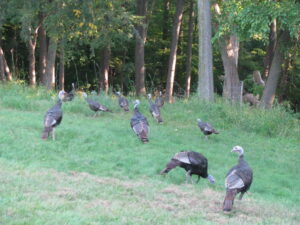
-
A dozen or so males routinely visited the yard.
-
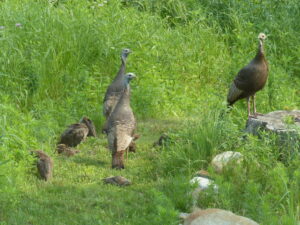
-
Rarely we would see hens with young.
About two years ago a threesome of males began visiting every day. Sometimes two or three times a day. We called them Huey, Duey and Louie. They seemed inseparable, and we never saw them alone. Late evenings we sometimes watched them flap up to tall tree branches to roost for the night.
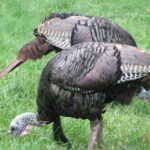
Huey and Louie
Then, only two visited. Huey and Louie. We never learned what happened to Duey. Maybe a predator enjoyed him for a meal. Or, he may have had an accident. It is a mystery, but we continued enjoying visits by the other two.
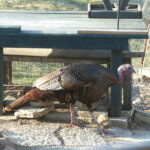
Lonely Louie looks for corn
One day Louie showed up alone. We haven’t seen his companion since. Lonely Louie is now trully a loner. If he’s in the yard and a flock of turkeys appears Louie stays away. He seems shunned by the others. Maybe he’s just shy.
He seems to miss his two friends. So do we, but we enjoy seeing Lonely Louie and know he appreciates the scoop of corn we toss out when he arrives.
by Marion Patterson | Apr 13, 2023 | Amphibians/Reptiles, Birds, Flowers/Grasses, Hearing, Nature, Wonderment
A Season of Variables
After a drab March “look up, look down, listen” season is here. It’s exciting and frustrating. Always something to see and hear and things we miss, too.
What is look up, look down, listen? Well, when we walk in woods and prairies, we’re always attuned to nature’s beauty and curiosities. In the Northern Hemisphere April and May force challenges and delights, as the earth turns toward the sun. Its warmth stimulates new life while welcoming arrivals from down south.
Here in Iowa, like much of the United States, bird migration rises through April and peaks in early May. Woods, wetlands, and prairies are filled with bird species we haven’t seen since last year.
Look Up!
“Look up,” Marion remarked on one April walk last year. She spotted the first Rose Breasted Grosbeak of the season. He was perched on a thin branch high in a sycamore tree. As we walked along, we kept looking up to spot other new arrivals. They added color and song to those of cardinals, chickadees, and woodpeckers who are our neighbors all year.
-
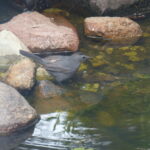
-
A catbird drinks by a pool.
-
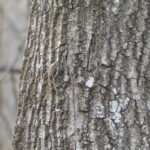
-
The brown creeper blends in with tree trunks.
Look Down!
After admiring the Grosbeak and moving on, I said, “look down.” We had been paying so much attention to birds up in the trees that we almost trampled a Dutchman’s Breeches, a delicate white wildflower with petals shaped like old-time Dutch pants. Looking down revealed spring beauties, Mayapples, hepatica, and anemones. Some were not quite in bloom and a few had gone by, but most were in their spring glory.
-
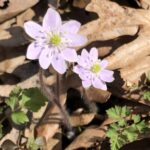
-
Early spring flowers
-
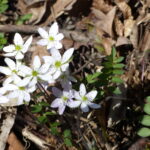
-
Reaching for the sun
-
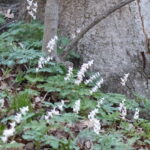
-
Dutchman’s Britches
-
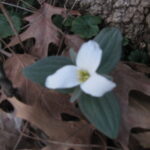
-
Snow Trillium
Shhhh! Listen
Passing a low wetland, we both paused to hear the songs of the chorus frogs and peepers that greet listeners each spring between the vernal equinox and Easter.
So, what do we do on a spring walk? Look up or down or listen? All of these. It is the best time of year to enjoy beauty clinging to the soil, singing from treetops, and chorusing from ephemeral pools.
Make Nature ID easier with Apps
Spotting birds hiding invisibly in tangles of branches and vines is challenging. What’s in that thicket singing? Thanks to the Cornell Laboratory of Ornithology, we turn on our Merlin app, point the phone where the songs originate, and learn who’s singing. Merlin is easy to download from the app store. Sometimes we are lucky and watch migratory birds close at hand.
Some people even lure birds in with treats that are eagerly consumed by arriving birds.
Wildflowers cannot hide but can be confusing. We sometimes use an app called SEEK to identify ones that are mysterious to us. SEEK is also easy to download from the app store and can also help identify trees, weeds, and other living things.
Look up, look down, listen! season may be the very best time to be outside. We love it.
























